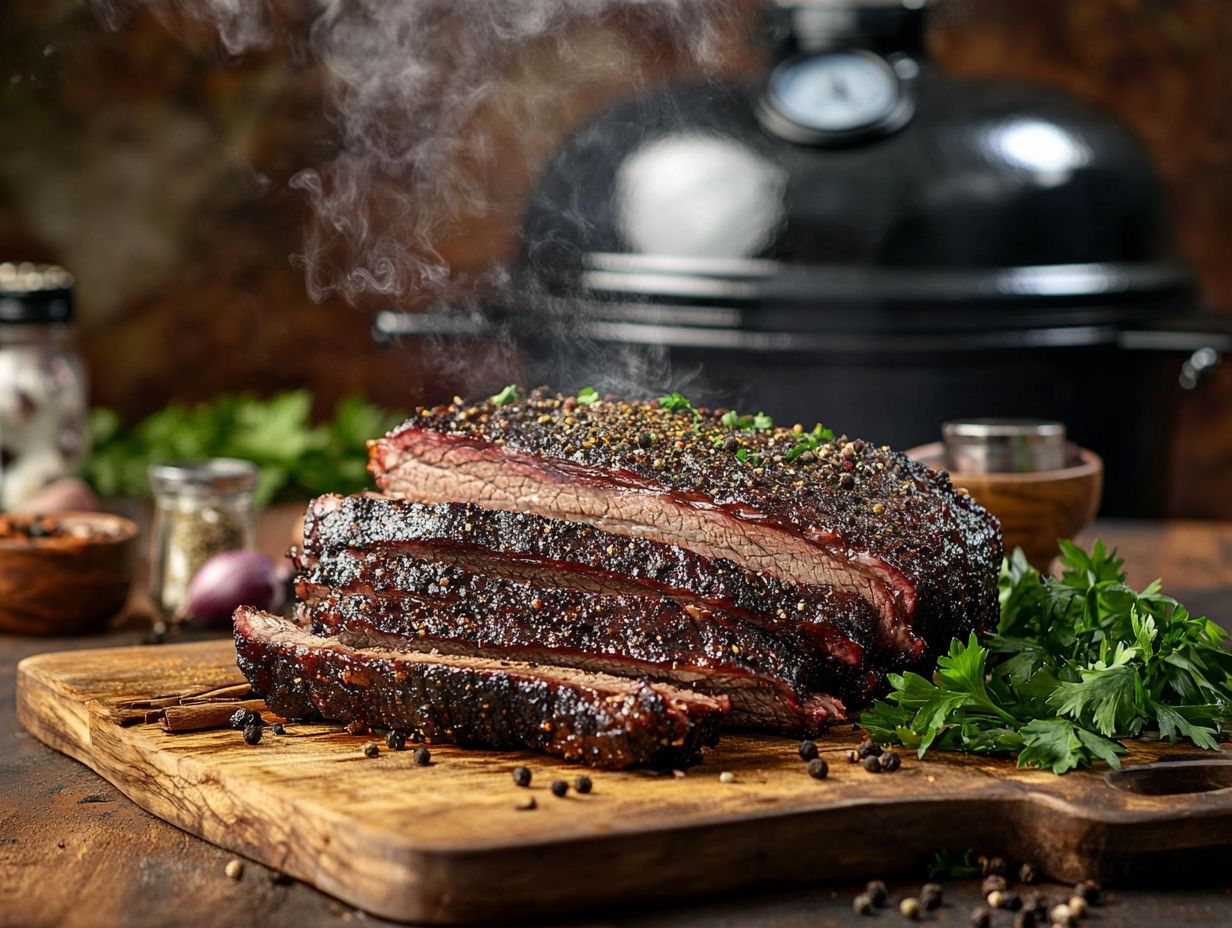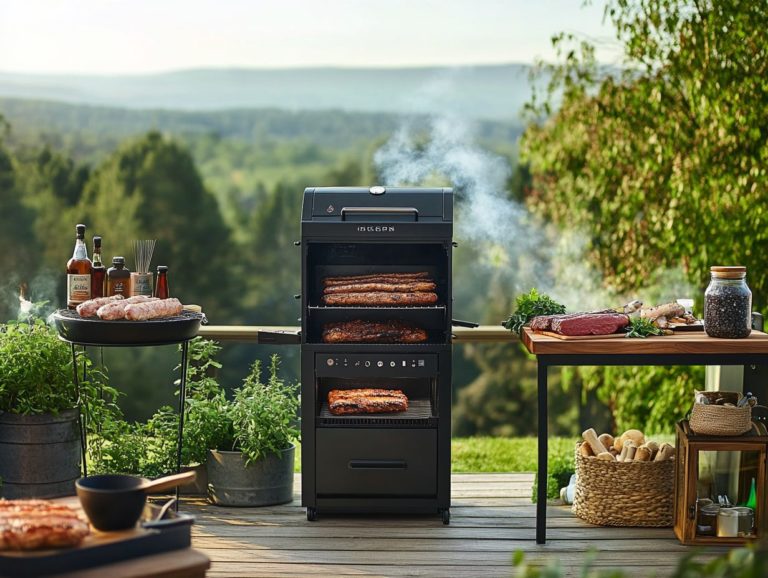The Science Behind Smoking Meat
Smoking meat transcends mere cooking; it s a delightful blend of art and science that transforms ordinary cuts into exquisite delicacies.
This exciting process enhances flavor through distinctive chemical reactions. You’ll need to select the right wood types to achieve the ideal balance between taste and smoke intensity.
You’ll explore essential techniques, indispensable tools, and crucial health considerations for smoking meat, along with expert tips to ensure your next barbecue is nothing short of spectacular.
Prepare to elevate your culinary prowess to new heights!
Contents
- Key Takeaways:
- The Science Behind Smoking Meat
- Types of Wood for Smoking Meat
- Equipment and Techniques for Smoking Meat
- Health Considerations for Smoking Meat
- Tips for Perfectly Smoked Meat: Understanding the Science Behind Smoking
- Frequently Asked Questions
- What is the science behind smoking meat and chemical reactions involved?
- How does smoking meat preserve it and contribute to its unique flavor?
- Why does smoked meat have a distinct flavor, and how does it relate to the type of wood used?
- What is the role of temperature in smoking meat and thermophoresis?
- How does the type of wood impact the smoking process and the resulting beef aroma?
- Is there a health benefit to smoking meat and understanding smoking advantages?
Key Takeaways:

- Smoking meat is a cooking technique that involves exposing meat to smoke and low temperatures for extended periods.
- Chemical reactions during smoking contribute to the unique flavor and texture of smoked meat. The type of wood used can greatly impact the intensity and type of smoke flavor.
- Proper equipment and techniques, along with following recommended health precautions, are crucial for safely and successfully smoking meat. Expert tips can also help achieve perfectly smoked meat.
What is Smoking Meat?
Smoking meat is a time-honored cooking method that infuses various types of meat with delicious flavor. By exposing the meat to smoke from burning or smoldering materials, often wood, you not only impart a rich flavor but also help retain moisture, preventing dryness during the cooking process.
This method can be applied to different cuts of meat, ensuring each one receives the perfect balance of smoky flavor and tenderness.
Rooted in ancient practices, the art of smoking meat transcends cultures and cuisines. Different regions embrace unique techniques that celebrate their local traditions. From the low and slow methods found in Southern barbecue to the quicker hot smoking approaches popular in various Asian cuisines, each technique adds its own distinct characteristics to your table.
As the meat absorbs that smoky essence, it becomes irresistibly tender, enhancing the entire dining experience. The infusion of spices and herbs during smoking opens up endless flavor possibilities, transforming this age-old practice into more than just a cooking method it becomes a cultural celebration that continues to evolve.
The Science Behind Smoking Meat
Understanding the science behind smoking meat is crucial for elevating your barbecue experience. It involves intricate chemical reactions that enhance both flavor and texture. For instance, the Maillard reaction is a process that gives food a tasty brown crust, crucial for developing those distinct flavor compounds.
This fascinating process occurs when proteins and sugars react under heat, resulting in that irresistible savory crust on the surface of the meat. Mastering temperature control is essential; different types of meat demand specific temperature ranges for optimal tenderness and flavor.
Dive into these elements, and you’re well on your way to achieving smoking perfection.
Chemical Reactions and Flavor Development
The chemical reactions that unfold during the smoking process are vital for flavor development. Primarily driven by the Maillard reaction, this fascinating reaction generates a variety of flavor compounds that elevate the taste and aroma of the meat you’re preparing.
As smoke envelops the meat, it creates a distinctive smoke ring and infuses savory flavors, enhancing the appearance and texture of the final dish.
This intricate process involves the browning of amino acids and sugars, which produces mouthwatering flavors and results in an enticing crust. The caramelization of sugars released during smoking complements the Maillard reaction, layering sweetness and depth to the overall flavor profile.
Plus, these reactions introduce tiny smoke particles that enrich the flavor and aroma, making the meat even more irresistible. By understanding these reactions, you can truly master the art of smoking. This knowledge enables you to manipulate temperature, time, and wood selection, allowing you to achieve the perfect blend of flavors tailored to your personal taste.
Start experimenting today, and make your next barbecue an unforgettable feast!
Types of Wood for Smoking Meat

Selecting the ideal wood types for smoking meat is a decision that profoundly impacts the flavor profile and intensity of your final dish. This choice is essential for any barbecue aficionado.
Woods like hickory and mesquite deliver a robust, assertive flavor. In contrast, fruit woods such as apple and cherry impart a gentler, sweeter essence.
This variety allows you to craft smoking experiences that suit different types of meat, elevating your dishes to new heights.
Impact on Flavor and Smoke Intensity
Wood types significantly influence smoke flavor and intensity. Each variety adds unique flavor compounds, enhancing the overall taste of your smoked meat. For example, hickory provides a robust, hearty flavor, while mesquite offers a more intense smokiness. These are go-to choices for barbecue enthusiasts eager to create a memorable dining experience.
Fruit woods like apple and cherry add sweet and subtle notes. They are perfect for delicate meats such as poultry and pork, balancing richness with fragrant undertones.
On the other hand, oak, known for its versatility, offers a moderate smoke that complements a variety of meats, delivering depth of flavor without overwhelming the palate.
By understanding the characteristics of each wood type, you can significantly enhance your smoking process. This knowledge allows you to tailor your approach based on the specific meat you’re preparing, whether it’s brisket, ribs, or even fish.
Equipment and Techniques for Smoking Meat
When you start smoking meat, having the right equipment and techniques is essential for achieving exceptional results. This is key to making your flavors pop while preserving the meat’s tenderness and moisture.
You ll find an array of smoking equipment at your disposal, including pellet smokers, charcoal smokers, electric smokers, and propane smokers. Each option comes with its own distinct advantages and supports various smoking techniques tailored to different cooking styles.
Recommended Tools and Techniques
To achieve the best results when smoking meat, having the right barbecue tools and employing effective smoking techniques is essential for ensuring proper temperature control and moisture retention throughout the cooking process. From thermometers that monitor internal temperatures to moisture trays that maintain juiciness, the right equipment significantly enhances your overall smoking experience.
A reliable digital meat thermometer is essential. It helps you check the internal temperature accurately, preventing the perils of overcooking or undercooking. Incorporating a moisture tray filled with water or aromatic liquids, like apple juice, can greatly contribute to a tender and flavorful final product.
Other essential tools include quality charcoal or wood pellets, which infuse your meat with rich, smoky flavors. It’s also wise to have sturdy barbecue gloves and a good set of tongs for safe handling. Mastering these elements not only elevates the quality of your smoked meats but also transforms the entire cooking process into an enjoyable and rewarding endeavor.
Health Considerations for Smoking Meat

Smoking meat gives you a delicious flavor, but it’s important to be aware of the health considerations before you start smoking. There are potential health risks that come into play.
By understanding these risks and implementing suitable precautions, you can enjoy the art of smoking meat while safeguarding your health and ensuring that this culinary practice remains a pleasurable endeavor.
Potential Health Risks and Precautions
Smoking meat can pose health risks. These arise from harmful chemicals produced during the process.
Compounds like polycyclic aromatic hydrocarbons (PAHs) form when fat drips onto hot surfaces, creating smoke that envelops the meat. These can be harmful if eaten often.
To alleviate these health concerns, balance your smoked meat intake with healthier choices. Opt for fruit trees or hardwoods, which produce less harmful smoke than resinous varieties. Soaking the wood chips before smoking significantly reduces PAH formation, leading to a safer and more enjoyable culinary experience.
Tips for Perfectly Smoked Meat: Understanding the Science Behind Smoking
If you’re aiming to achieve perfectly smoked meat, several expert tips can elevate the flavor and texture of your dish, guaranteeing delicious results every time. Master temperature control and understand moisture retention to take your smoking game to the next level, whether you’re a novice or a seasoned barbecue enthusiast.
Expert Tips and Tricks for Delicious Results
To achieve mouthwatering results when smoking meat, incorporating expert tips can enhance the flavor and texture you desire. By understanding the specific requirements for different types of meat, and mastering temperature control and timing, you ll create barbecue that leaves a lasting impression.
For example, smoking brisket demands patience and a consistent low-and-slow approach, typically around 225 F to 250 F. In contrast, poultry such as chicken or turkey thrives at a higher temperature, ideally between 275 F and 300 F, to achieve that coveted crispy skin while ensuring the meat remains juicy.
Timing is equally crucial. Larger cuts may require several hours to develop rich, complex flavors, while smaller pieces can be ready much more quickly. By embracing these tailored techniques, you can elevate your smoking game, producing flavorful creations that are sure to make a statement at any gathering.
Frequently Asked Questions

What is the science behind smoking meat and chemical reactions involved?
The process of smoking meat involves exposing it to smoke from burning wood or charcoal. The smoke contains various compounds, such as phenols and aldehydes, which give the meat a distinct flavor and act as preservatives.
How does smoking meat preserve it and contribute to its unique flavor?
Smoking meat exposes it to low temperatures and smoke, which serve as natural preservatives. The smoke contains antimicrobial compounds that inhibit the growth of bacteria and prevent the meat from spoiling.
Why does smoked meat have a distinct flavor, and how does it relate to the type of wood used?
The unique flavor of smoked meat comes from the compounds in the smoke, produced when wood or charcoal burns. These compounds infuse into the meat, giving it a rich, smoky flavor.
What is the role of temperature in smoking meat and thermophoresis?
The temperature used in smoking meat is crucial because it affects the texture, flavor, and safety of the meat. Low temperatures (around 200-250 F) allow for slow cooking and prevent the meat from drying out.
How does the type of wood impact the smoking process and the resulting beef aroma?
The type of wood used for smoking can greatly impact the flavor of the meat. Different types of wood produce different smoke compounds, which can give a unique flavor to the meat. For example, hickory wood produces a strong, smoky flavor, while fruit woods, like apple or cherry, give a sweeter taste.
Is there a health benefit to smoking meat and understanding smoking advantages?
Smoking meat adds delicious flavor to your meals. However, it also produces cancer-causing substances, like polycyclic aromatic hydrocarbons (PAHs) and heterocyclic amines (HCAs).
Eating a lot of smoked meat may raise your risk of certain cancers. Enjoy smoked meat in moderation to savor the flavor while keeping your health in check!






